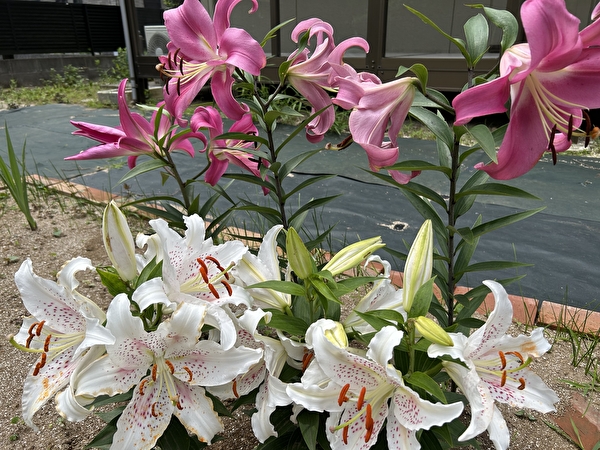「ユリの花」
Do you know about Japanese flowers? The lilies, native to the wilds of Japan became the progenitors of lily breeding in the West. At 4T-AMKY, Teachers and Students write about Japanese culture, food, history, many spots to visit, and other stuff. Enjoy reading and knowing about deeper Japanese culture!
Lilies
History and Types of Lilies
The top photo shows Casablanca (Lilium ‘CASA Blanca’) blooming in my garden this July. The large, brightly colored, and richly scented flowers made the garden suddenly more gorgeous. Casablanca is a horticultural variety created by crossbreeding the Japanese natives Yamayuri and Kanokoyuri.
Lilies have been familiar to the Japanese since ancient times, appearing in the Kojiki (Records of Ancient Matters) and Nihonshoki (Chronicles of Japan) and being frequently mentioned in poetry during the Nara era (710-794). There are approximately a 100 species of lilies in the world, with 15 of them being native to Japan.
It is said that at the end of the Edo era (1603-1867), the German physician Siebold and others brought the bulbs back from Japan during their investigations of the plants. Later, bulbs such as Teppoyuri (Easter lily, Lilium longiflorum), Yamayuri (Gold-banded lily, Lilium auratum), Kanokoyuri (Lilium speciosum), and Sukashiyuri (Lilium maculatum Thunb) became popular in Europe.
Lily breeding and improvement became active in Europe and the United States, particularly in the Netherlands. It is said that lilies distributed in the flower industry in Japan and around the world today contain almost all the genes of lilies that originated in Japan. Thus, the lilies native to Japan became the progenitors of breeding in the West.
Now I understand why various kinds of lilies are always available in abundance. Additionally, I was once again reminded of the happiness of being able to see various kinds of lilies while walking in fields or in other people’s gardens during early summer and summer in Japan.
Here are some pictures and photos of lilies I actually came across.
Yamayuri (Gold-banded lily, Lilium auratum)

Kanokoyuri (Lilium speciosum)


Sukashiyuri (Lilium maculatum Thunb)

Oniyuri (Tiger Lily, Lilium lancifolium)


Shinteppoyuri


Shinteppoyuri is the result of a cross between the Japanese Teppoyuri and Takasago lily, which is native to Taiwan. The Takasago lily was introduced to Japan and became wild, leading to natural hybridization with Teppoyuri throughout Japan. This variety reproduces by seeds being carried by the wind, so it has grown naturally in my garden.
「ユリの花」
ユリの歴史と種類
トップの写真は、7月に我が家の庭に咲いたカサブランカです。大輪で色鮮やか、香りも濃厚で庭が一気に華やぎました。カサブランカは日本原産のヤマユリとカノコユリを交配させてできた園芸品種です。
ユリは、『古事記』『日本書紀』にも登場し、奈良時代には歌にも多く詠まれ、日本人には古くからとても親しみのある花です。世界にユリの原種は約100種ありますが、15種類が日本の自生種だそうです。
江戸時代の末期に、ドイツ人医師・シーボルトなどが植物を調査する過程で球根を日本から持ち帰ったと言われています。その後、テッポウユリを始め、ヤマユリ、カノコユリ、スカシユリなどの球根が欧州で人気を集めました。
ユリの育種・品種改良は、欧米、特にオランダを中心に活発化しました。現在、日本だけではなく世界の花業界で流通するユリには、元をたどれば日本原産のユリの遺伝子がほぼ含まれていると言われています。日本原産のユリは欧米での品種改良の始祖となったというわけです。
様々な種類のユリがいつでも豊富に出回っている理由がわかりました。日本では初夏から夏の間、野山を歩いている時や、よそのお宅のお庭でも、様々な種類のユリに出合える幸せを改めて感じました。
私が実際に出合ったユリを絵と写真で紹介します。
ヤマユリ
カノコユリ
スカシユリ
オニユリ
シンテッポウユリ
シンテッポウユリは、日本のテッポウユリと台湾原産のタカサゴユリの交配で生まれました。日本に導入されたタカサゴユリが野生化し、日本各地でテッポウユリとの自然交配が起こりました。種が風に飛ばされて増えるので、我が家の庭にも自然に生えてきました。
Ikuyo.K.






